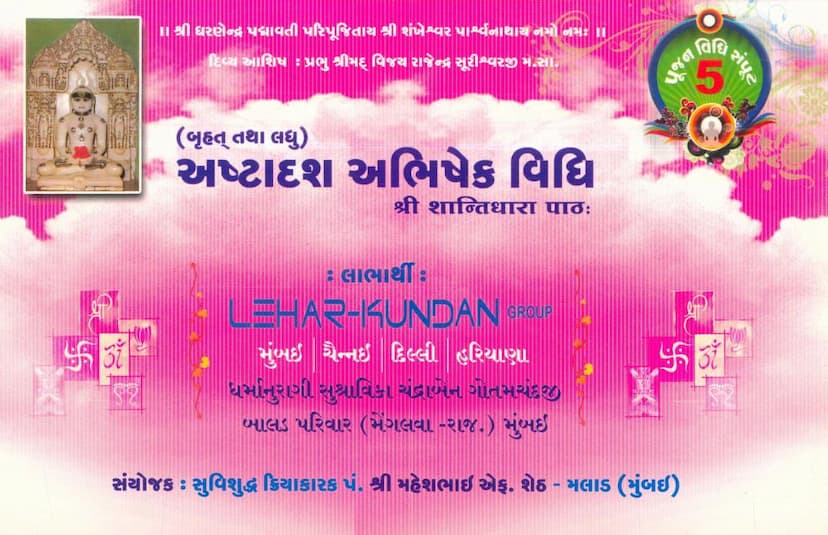Poojan Vidhi Samput 05 Ashtadash Abhishek Vidhi
Added to library: September 2, 2025

Summary
This Jain text, titled "Poojan Vidhi Samput 05 Ashtadash Abhishek Vidhi," is a guide to performing the "Eighteen Abhishekas" (ritual ablutions) for Jain deities.
Here's a comprehensive summary of its content:
Overall Purpose: The book details the procedures for performing eighteen different types of abhisheka (ritualistic bathing or consecration) of the sacred images (murtis or bimbas) of Jain Tirthankaras. These rituals are performed for various significant occasions:
- Prana Pratishtha (Installation of new murtis): Consecrating new idols in a temple.
- Purification: When idols are moved from one place to another.
- Remedy for Defilement: To rectify any instances of ashatana (disrespect or transgression) that may have occurred in the temple.
Key Components and Procedures:
-
Invocation and Blessings:
- The text begins with salutations to Lord Shankheshwar Parshvanath, revered by Dharanendra and Padmavati, and includes blessings from His Holiness Acharya Shri Vijay Rajendrasurishwarji Maharaj.
- It acknowledges donors and coordinators, highlighting the spiritual support and contributions.
-
Preparation:
- Gathering Materials: All necessary items for the eighteen abhishekas must be meticulously prepared.
- Mantra Chanting: The materials are to be sanctified by a learned priest (Gurumaharaj) with specific mantras, often accompanied by vaskshep (blessed rice grains).
- Soaking Herbs: Medicinal herbs should be pre-soaked to enhance their potency.
- Singing Ragas: The Snatra (hymns sung during the ritual) should be performed with appropriate melodies and emotional expression.
-
General Ritual Steps (Repeated for each Abhisheka):
- Self-Protection: Before commencing the rituals, the practitioner recites the Vajrapanjar Stotra for spiritual protection.
- Offering Flowers (Kusumanjali): Three offerings of flowers are made to the deity.
- The Abhisheka Itself: This involves pouring various mixtures, as described below, over the deity's idol from a pot (kalash).
- Deity Invocation (Yanjan Pool): Mantras are recited to invoke specific elemental energies or qualities associated with the deity's body (earth, water, fire, etc.) to receive the offerings.
- Offerings: This is followed by traditional offerings of Chandan (sandalwood paste), Pushpa (flowers), Dhoopa (incense), and Deep (lamp).
- Food Offering (Naivedya) and Fruit: A symbolic offering of food and fruit is made, often preceded by a swastika drawn with rice.
-
The Eighteen Abhishekas (The Core of the Book): The book then systematically details eighteen distinct abhishekas, each using a specific ingredient or combination:
- 1. Suvarna Churna Snatra (Golden Powder Ablution): Using water mixed with gold powder.
- 2. Pancharatna Churna Snatra (Five Gem Powder Ablution): Using water mixed with powders of gold, silver, pearls, rubies, and coral.
- 3. Kashaya Churna Snatra (Astringent Herb Powder Ablution): Using water mixed with powders of various astringent herbs (like Pippali, Pipla, etc.).
- 4. Mangala Mruttika Snatra (Auspicious Earth Ablution): Using water mixed with sacred earth from various pure locations.
- 5. Padmamrita Snatra (Five Nectars Ablution - Panchagavya/Panchamrita): Using mixtures derived from cow products (milk, yogurt, ghee, etc.) or Panchamrita (milk, yogurt, ghee, sugar, honey/water).
- 6. Shatamoolika Snatra (Hundred Root Ablution): Using water mixed with powders of 100 or 21 specific medicinal roots.
- 7. Kushthaadi Prathama Ashtaka Varga Snatra (First Eightfold Herbal Group Ablution): Using water mixed with powders of a specific group of eight medicinal herbs.
- 8. Patanjaryadi Dwitiya Ashtaka Varga Snatra (Second Eightfold Herbal Group Ablution): Using water mixed with powders of another set of eight medicinal herbs.
- 9. Saushadhi Snatra (Medicinal Herb Ablution): Using water mixed with various medicinal herbs like Priyangu, Vatsaka, etc.
- 10. Sugandhosadhi Sahastramoolika Sarvoshadhi Snatra (Fragrant Herbs, Thousand Roots, All Herbs Ablution): Using water mixed with a wide array of aromatic herbs and roots.
- 11. Pushpa Snatra (Flower Ablution): Using water mixed with fragrant flower petals.
- 12. Gandha Snatra (Fragrant Substance Ablution): Using water mixed with fragrant substances like sandalwood, musk, saffron, etc. (specifically yaksha kardam is mentioned here).
- 13. Vasa Snatra (Aromatic Wood Ablution): Using water mixed with fragrant wood powders (vasakshipta).
- 14. Ksheer Chandan Snatra (Milk and Sandalwood Ablution): Using water mixed with milk and sandalwood paste.
- 15. Keshara Sharkara Snatra (Saffron and Sugar Ablution): Using water mixed with saffron and sugar.
- 16. Teerthodaka Snatra (Sacred Water Ablution): Using water from various holy places.
- 17. Karpura Snatra (Camphor Ablution): Using water mixed with camphor.
- 18. Keshara Kasturika Chandan Snatra (Saffron, Musk, Sandalwood Ablution): Using water mixed with saffron, musk, and sandalwood.
-
Special Rituals:
- Chandra Darshan (Moon Viewing) & Surya Darshan (Sun Viewing): Performed typically during Anjanshalaka (eye-opening ceremony) or the eighteen abhishek occasion. The deity's image is shown a mirror reflecting the moon or sun, accompanied by specific mantras for prosperity and well-being of the lineage.
-
Post-Eighteen Abhisheka Rituals:
- Five Additional Abhishekas: After the eighteen, there are five more specific abhishek rituals mentioned: Ghee, Milk, Yogurt, Sugarcane Juice, and All-Herbal mixtures.
- Wiping and Tilak: After each abhisheka, the idol is wiped, a tilak (forehead mark) is applied with the thumb, and prayers are offered.
- 108 Abhishekas: If time permits, 108 abhishek rituals can be performed, or a shorter version of eight.
- Ashta Prakari Puja: The eightfold worship (offering sandalwood, flowers, incense, lamp, food, fruit, betel nut, and camphor) is performed.
- Chaityavandan: Salutations to the Jain shrines and deities.
- Aarti: The ritual of waving a lamp.
- Shanti Kalash Filling: Filling a pot with the water from the abhishek, accompanied by the Great Shanti Path.
- Forgiveness (Kshama Prarthana): Seeking forgiveness for any errors made during the rituals.
-
Concluding Verses:
- The book ends with prayers for peace, prosperity, and the glory of the Jain religion, as well as salutations to various guardian deities and the spiritual lineage. It emphasizes the importance of the Jain Shasan (dispensation).
Significance: This text is a practical manual for priests and devout laypersons to conduct elaborate and auspicious ceremonies dedicated to the Jain Tirthankaras, aiming to purify, sanctify, and invoke blessings. The detailed instructions ensure that the rituals are performed correctly according to Jain tradition.